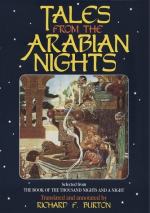[FN#218] This is our tale of “The Maid and the Magpie;” the Mac. Edit. does not specify the “Tayr” (any bird) but the Bresl. Edit. has Ak’ak, a pie. The true Magpie (C. Pica) called Buzarai (?) and Zaghzaghan Abu Massah (=the Sweeper, from its tail) is found on the Libanus and Anti-Libanus (Unexplored Syria ii. 77-143), but I never saw it in other parts of Syria or in Arabia. It is completely ignored by the Reverend Mr. Tristram in his painfully superficial book “The Natural History of the Bible,” published by the Society for Promoting Christian Knowledge (or rather Ignorance), London, 1873.
[FN#219] This is “The Story of the Two Partridges,” told at great length in the Book of Sindibad. See De Sacy’s text in the Kalilah wa Damnah, quoted in the “Book of Kalilah and Damnah” (p. 306).
[FN#220] This extremely wilful young person had rendered rape excusable. The same treat- ment is much called for by certain heroines of modern fiction—let me mention Princess Napraxine.
[FN#221] The Story of the Hidden Robe, in the Book of Sindibad; where it is told with all manner of Persian embellishments.
[FN#222] Now turned into Government offices for local administration; a “Tribunal of Commerce,” etc.
[FN#223] Arab. “Bawwab,” a personage as important as the old French concierge and a man of trust who has charge of the keys and with letting vacant rooms. In Egypt the Berber from the Upper Nile is the favourite suisse; being held more honest or rather less rascally than the usual Egyptian. These Berbers, however, are true barbarians, overfond of Buzah (the beer of Osiris) and not unfrequently dangerous. They are supposed by Moslems to descend from the old Syrians expelled by Joshua. For the favourite chaff against them, eating the dog (not the puppy-pie), see Pilgrimage i. 93. They are the “paddies’, of Egypt to whom all kinds of bulls and blunders are attributed.
[FN#224] Arab. “Juma’ah,” which means either Friday or a week. In pre-Moslem times it was called Al-Arubah (the other week-days being Shiyar or Saturday, Bawal, Bahan Jabar, Dabar and Famunis or Thursday). Juma’ah, literally = “Meeting” or Congregation (-day), was made to represent the Jewish Sabbath and the Christian Sunday because on that day Allah ended the work of creation; it was also the date of Mohammed’s entering Al-Medinah. According to Al-Bayzawi, it was called Assembly day because Ka’ab ibn Lowa, one of the Prophet’s ancestors, used to gather the people before him on Fridays. Moslems are not forbidden to do secular work after the congregational prayers at the hour when they must “hasten to the commemoration of Allah and leave merchandising.” (Koran, chaps. Ixii. 9.)
[FN#225] This is done only by the very pious: if they see a bit of bread they kiss it, place it upon their heads and deposit it upon a wall or some place where it will not be trodden on. She also removed the stones lest haply they prove stumbling-blocks to some Moslem foot.




